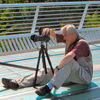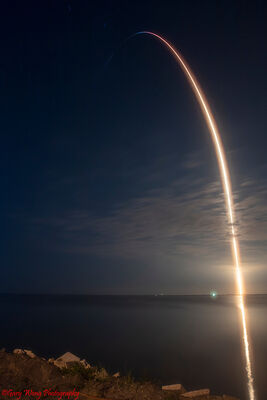Monopod Practice Makes Perfect?
Jun 10, 2013 16:45:07 #
I took my monopod out birding with me on Sunday for a field trip. I'm using a 7D and a 100-400mm lens. It's a Gitzo monopod and a Manfrotto 234RC Tilt head. Honestly it spent more time lying on the ground than with my camera mounted on it. I almost lost it once, I couldn't remember where I'd laid it down. I guess it's going to be awkward at first and I should keep trying? I felt inhibited by it, but maybe a lot of that was trying to find the right height for shooting up, shooting down, shooting out, figuring out when I should keep the tilt loosened and when I should lock it. Locking it seemed best only when I had it slung over my shoulder. That was actually my favorite feature (it's convenient and it looks cool). Any comments would be appreciated. No dire problem here, just trolling for some constructive feedback if you feel like it. Thanks!
Jun 10, 2013 16:58:45 #
Practice Makes Perfect?...I don't know but it sure helps. I use my mono pod now with a ball head mounted on the thing...and just enough tension I can move the lens with my left hand...and a cable release and pod in my right hand. With these big lens's every little bit will help.
Jun 10, 2013 17:19:10 #
I also find the use out my mono pod backward. But I do need to sue it more to get used to it. Like Bret said practice helps.
Jun 10, 2013 17:23:50 #
Bret wrote:
Practice Makes Perfect?...I don't know but it sure helps. I use my mono pod now with a ball head mounted on the thing...and just enough tension I can move the lens with my left hand...and a cable release and pod in my right hand. With these big lens's every little bit will help.
Interesting. A ball-head with some tension seems to make sense. I use bb focus, so my camera needs both my hands. I'm envisioning not holding the pod at all and having the head loose enough so the pod will follow my positioning of the camera, but engaged enough so it helps with the "steady" when I need it. Maybe it's just the head that's bothering me and I need free lateral movement as well. Thanks for posting.
Jun 10, 2013 17:36:57 #
aerides wrote:
I took my monopod out birding with me on Sunday fo... (show quote)
I'm more of a landscape shooter, so the monopod works well when packing the tripod around isn't convenient. I'm not sure it's a good solution when trying to shoot quickly in multiple directions or following moving subjects. Good luck.
Jun 11, 2013 03:00:28 #
The following is not the only way to use a monopod, maybe even not the best, but it works for me and many professionals I know. If you have a camera with only an LCD screen and no viewfinder, this set of instructions will not work for you; you must have a viewfinder. The instructions below are written as though this was THE way to use a monopod. I hope some of you find them useful:
To begin, you must have a head on your monopod that will allow you to tilt your camera forward. The monopod should be long enough so that, when fully extended, the optical or electronic viewfinder of your camera, on the tilt head on your monopod is slightly higher than your eye, that's right higher. Now stand with your feet approximately shoulder with apart with both feet flat. Position the monopod approximately one foot in front of the toes of your shoes and centered on your body. Now, here's where the tilt head comes in. Tilt the monopod backward toward your face and, at the same time, tilt the camera forward so it remains level. Without bending your knees, lean forward so a small portion of your weight is on the monopod. Adjust the distance of the monopod in front of you (and, at the same time, adjust the tilt of the camera) so that when you lock your eye into the viewfinder, you are leaning forward slightly. The monopod and your two legs should form a TRIPOD. The last word in the previous sentence, the one in all caps is the secret to using the monopod. Quite simply, the monopod is not a vertical support of your camera, it is the third leg of a highly effective tripod. Good luck!
------------Originally Posted 05/28/2013
To begin, you must have a head on your monopod that will allow you to tilt your camera forward. The monopod should be long enough so that, when fully extended, the optical or electronic viewfinder of your camera, on the tilt head on your monopod is slightly higher than your eye, that's right higher. Now stand with your feet approximately shoulder with apart with both feet flat. Position the monopod approximately one foot in front of the toes of your shoes and centered on your body. Now, here's where the tilt head comes in. Tilt the monopod backward toward your face and, at the same time, tilt the camera forward so it remains level. Without bending your knees, lean forward so a small portion of your weight is on the monopod. Adjust the distance of the monopod in front of you (and, at the same time, adjust the tilt of the camera) so that when you lock your eye into the viewfinder, you are leaning forward slightly. The monopod and your two legs should form a TRIPOD. The last word in the previous sentence, the one in all caps is the secret to using the monopod. Quite simply, the monopod is not a vertical support of your camera, it is the third leg of a highly effective tripod. Good luck!
------------Originally Posted 05/28/2013
Jun 11, 2013 03:21:58 #
Mogul wrote:
The monopod and your two legs should form a TRIPOD. The last word in the previous sentence, the one in all caps is the secret to using the monopod. Quite simply, the monopod is not a vertical support of your camera, it is the third leg of a highly effective tripod. Good luck!
------------Originally Posted 05/28/2013
------------Originally Posted 05/28/2013
I'm going to have to try this...I have a monopod that I haven't used much because apparently I didn't know who until now. Thanks for pointing this out.
Jun 11, 2013 07:03:03 #
It takes practice, like anything else, but very effective. It did not work for me until I bought the Manfrotto monopod head discussed above. Gary
Mogul wrote:
The following is not the only way to use a monopod... (show quote)
Jun 11, 2013 07:43:15 #
Street and event shooter. Always use my monopod. Photography begins with sharpness.
Jun 11, 2013 09:52:02 #
I am thinking of buying a monopod and have two questions. I am 70" tall. Most monopods are about 63". The tripod method seems to be method of choice. If that is true, then I would need a monopod of at least 72". Do you agree with that? Has anyone found one that long?
I will use the monopod for sports and low light settings. Some monopods come with a ball head. Does that provide sufficient mobility or should I by a separate head?
Thanks for the help.
I will use the monopod for sports and low light settings. Some monopods come with a ball head. Does that provide sufficient mobility or should I by a separate head?
Thanks for the help.
Jun 11, 2013 09:54:48 #
abc1234 wrote:
I am thinking of buying a monopod and have two questions. I am 70" tall. Most monopods are about 63". The tripod method seems to be method of choice. If that is true, then I would need a monopod of at least 72". Do you agree with that? Has anyone found one that long?
I will use the monopod for sports and low light settings. Some monopods come with a ball head. Does that provide sufficient mobility or should I by a separate head?
Thanks for the help.
I will use the monopod for sports and low light settings. Some monopods come with a ball head. Does that provide sufficient mobility or should I by a separate head?
Thanks for the help.
Not necessarily....since the bottom of the camera and the viewfinder are some 3" or 4" apart....you don't need to add that to the stick I think.
70" minus 2" to eye level = 68"
68" minus 3" from bottom of camera to viewfinder = 65"
All measurements are estimates.
I'm 6' 1.5" and mine works fine....and it's a bargain-basement special from Targus.
Jun 11, 2013 10:08:37 #
rpavich, thanks for the answers.
Regarding the height, when you set the foot a foot or so in from of myself, the Pythagorean theorem calculates the height of the monopod to be 71". That is my concern.
Any comments about no head versus built-in (on) ball head versus a separate head?
Regarding the height, when you set the foot a foot or so in from of myself, the Pythagorean theorem calculates the height of the monopod to be 71". That is my concern.
Any comments about no head versus built-in (on) ball head versus a separate head?
Jun 11, 2013 10:36:07 #
Mogul wrote:
The following is not the only way to use a monopod... (show quote)
I've wondered why anybody would go to the expense of adding a ball or any other kind of attachment to a monopod and now I see. Thanks for the informative info.
Jun 11, 2013 10:41:57 #
Tripod does one thing. Monopod does another. Not really comparable. Sometimes you be tall. Sometimes you be short.
Jun 11, 2013 10:52:47 #
While not in use of a monopod, I noticed you mentioned you almost lost yours a time or two. Something that I do is use the monopod as a walking stick, and most come with a wrist band aka strap. With this strap wrapped around your wrist and need to use the unattached camera, just drop the monopod and grab your camera. The monopod will dangle but is out of the way. No need to lay it down or bend over to pick up. Make sure the strap is loose enough to allow quick removal from your wrist for those time you wish to attach the camera; I had to change out the wrist strap on mine because it was too small for this action. Also make sure you use the strap the correct way, spread the strap loop and place your entire hand through the loop from underneath. Then spread your fingers and lower your hand onto the hand grip thus trapping the strap between your hand and the grip, this snugs the strap onto your wrist. This is the proper way for use of ski poles and walking sticks.
If you want to reply, then register here. Registration is free and your account is created instantly, so you can post right away.










